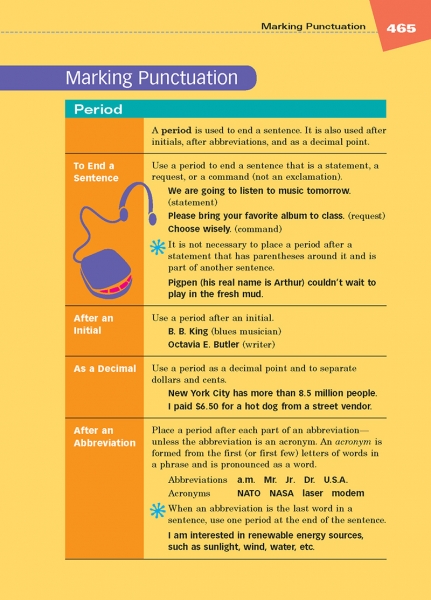Page 465 from

Start-Up Activity
Show students a stop sign and ask what it means. Of course, they will say, "Stop." Then show them a yield sign and ask what it means. Hopefully, they will say, "Slow down and check for traffic, continuing if the way is clear or giving way if it is not." The stop sign is easy. The yield sign is more complex.
The stop sign is a period. It's unambiguous, as the opening page shows. The yield sign is a comma. It has many uses in different circumstances. It's much more situational than the period. That's why this section has one page on periods and six pages on commas.
Now have students imagine roads with no traffic signs—or confusing, misleading, and contradictory traffic signs. All sorts of frustration and accidents would result. In the same way, writing that is missing punctuation or that uses punctuation incorrectly results in frustration and "accidents."
This section will help students use punctuation well to guide readers along.
Think About It
“To me, part of the beauty of a comma is that it offers a rest, like one in music: a break that gives the whole piece of music greater shape, deeper harmony. It allows us to catch our breath.”
—Pico Iyer

Start-Up Activity
Show students a stop sign and ask what it means. Of course, they will say, "Stop." Then show them a yield sign and ask what it means. Hopefully, they will say, "Slow down and check for traffic, continuing if the way is clear or giving way if it is not." The stop sign is easy. The yield sign is more complex.
The stop sign is a period. It's unambiguous, as the opening page shows. The yield sign is a comma. It has many uses in different circumstances. It's much more situational than the period. That's why this section has one page on periods and six pages on commas.
Now have students imagine roads with no traffic signs—or confusing, misleading, and contradictory traffic signs. All sorts of frustration and accidents would result. In the same way, writing that is missing punctuation or that uses punctuation incorrectly results in frustration and "accidents."
This section will help students use punctuation well to guide readers along.
Think About It
“To me, part of the beauty of a comma is that it offers a rest, like one in music: a break that gives the whole piece of music greater shape, deeper harmony. It allows us to catch our breath.”
—Pico Iyer





